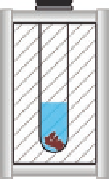Biomedical Engineering Reference
In-Depth Information
co-surfactant system are separately heated to a temperature above the melting
point of the solid lipid. The drug and the lipid are heated together to solubilize the
drug in the molten lipid. The lipid melt is later emulsified in the hot surfactant/co-
surfactant system under continuous stirring to yield a hot microemulsion, which is
then dispersed in cold water (typically 2-4 °C), under mechanical stirring, to yield
SLNs. Typically, microemulsion:aqueous phase ratios are 1:25 or 1:50.
3.2.3 Microwave-Assisted Microemulsion Technique
The use of microwave energy in chemical synthesis and processes has been widely
investigated in recent years (Gawande et al.
2014
). Microwave-assisted synthesis of
compound libraries for generation and optimization of new drug candidates is well-
established (Hayes
2004
). Microwave-assisted drying of pharmaceutical products
and long-term stability of solid dispersions of drugs is a widely reported applica-
tion (Bergese et al.
2003
; Moneghini et al.
2008
,
2009
). Only a few reported suc-
cesses of the use of microwave energy in pharmaceutical formulation, such as that
of polymeric nanoparticles, have been reported (An et al.
2006
; Bergese et al.
2003
;
Waters et al.
2011
). The authors of this topic have developed a novel production
technique for SLNs based on the use of microwave energy (Shah et al.
2014
).
Figure
3.4
gives a schematic diagram of steps involved in the microwave-
assisted microemulsion technique. The drug, lipid and aqueous surfactant/co-
surfactant system are subjected to controlled microwave heating at a temperature
above the melting point of the solid lipid. Constant stirring while heating the for-
mulation components in a controlled microwave environment yields a hot micro-
emulsion. Unlike the conventional microemulsion technique, all ingredients are
heated in a single synthesis vessel. This step is therefore referred to as “single pot”
production of microemulsion. The hot microemulsion obtained from the micro-
wave is again then dispersed in cold water (at 2-4 °C) to generate SLNs.
Fig. 3.4
Schematic steps
involved in the microwave-
assisted microemulsion
technique
Solid lipid
nanoparticles
Step 1: Microwave heating
of drug, lipid and aqueous
surfactant solution
Step 2: Dispering the
microemulsion from
microwave into cold water





Search WWH ::

Custom Search